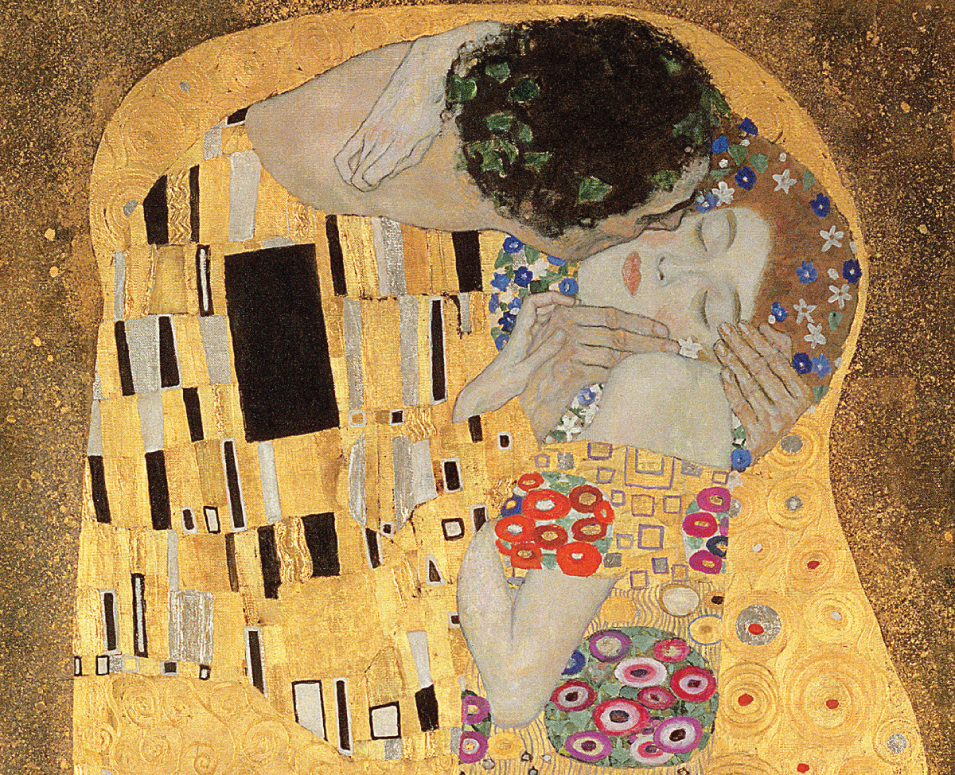Vienna at the end of the 19th century was a creative epicenter that spawned radical artistic and intellectual innovation. As Schorske noted, “Vienna in the
fin de siècle, with its acutely felt tremors of social and political disintegration, proved one of the most fertile breeding grounds of the 20th century's a-historical culture. Its great intellectual innovators—in music and philosophy, in economics and architecture and, of course, psychoanalysis—all broke, more or less deliberately, their ties to the historical outlook central to the 19th-century liberal culture in which they had been reared” (
1, p. xviii).
The painters Gustav Klimt (1862–1918) and Egon Schiele (1890–1918) were products of this cultural ferment. Klimt, a central figure in the Viennese secessionist movement (which rejected the classical realist tradition in painting), became famous for his abstractly ornamented sensual portraits of women (figure). He had been deeply influenced by his exposure to the Byzantine mosaics of Venice and Ravenna. These provided the inspiration for the ornamentation of his paintings, at the center of which was often an alluring woman. Schorske drew a parallel between the Viennese contemporaries Freud and Klimt: “Both loosed their chosen fields—psychology and art respectively—from their biological/anatomical moorings—–both plunged into the self and embarked on a
voyage intérieur—(and) explorations of the world of instinct” (
1, p. 208).
Klimt, who by the early 20th century was professionally successful and established, recognized the young Egon Schiele's talent and facilitated his gallery showings. Schiele, who was also a powerful portraitist and accomplished landscape painter, is best known for his watercolors and drawings with graphic and unflinching displays of the naked or, more often than not, half-clothed body and explicit exposure of genitalia. He made radical formal innovations, and as Danto has suggested, “In Schiele's work the human body expresses its sexuality as artistic truth” (
2). Classical concepts of beauty were jettisoned by Schiele, as his self-portraits with their distortions of physiognomy and wild intensity demonstrate. By 1910, Kallir observed, “Schiele resolved the conflict between decorative abstraction and conventional realism that had plagued Klimt's figural paintings by creating a new expressive pictorial language that leveled the formal and representational aspects of his compositions” (
3, p. 73). He was the harbinger of German Expressionism, which flowered in the work of Otto Dix and George Grosz during the Weimar Republic.
A contemporaneous parallel to Schiele's and Klimt's artistic expression of sexuality can be found in Freud's creation of “libido” theory and his 1905 publication of the Dora case, wherein a late-adolescent patient in psychoanalytic treatment is subjected, not necessarily therapeutically, to one breathtaking sexual interpretation after another.
Schiele challenged the viewer with his artistic assertion that raw sexuality is a crucial part of human reality and beauty and should be appreciated as such. Klimt was less provocative. His paintings have an aura of eroticism, but they are not as unsettling and disguise their intent to arouse the beholder. This dichotomy between Schiele's radical and Klimt's moderate approach to the portrayal of sexuality was played out on many fronts in early 20th-century Vienna. Freud's unwavering insistence on the absolute centrality of psychosexuality to psychoanalysis was challenged by many of his prominent followers, such as Jung and Adler, and led to theoretical wars that continue, in one form or another, to this day. With more than a century's hindsight it can be seen that Klimt and Schiele represent different but overlapping creative facets of the tempestuous cultural vortex that was fin de siècle Vienna, where sex was certainly in the air.
Acknowledgments
Detail from The Kiss (1907–1908, oil on canvas) by Gustav Klimt used by permission of Bridgeman Art Library International.


